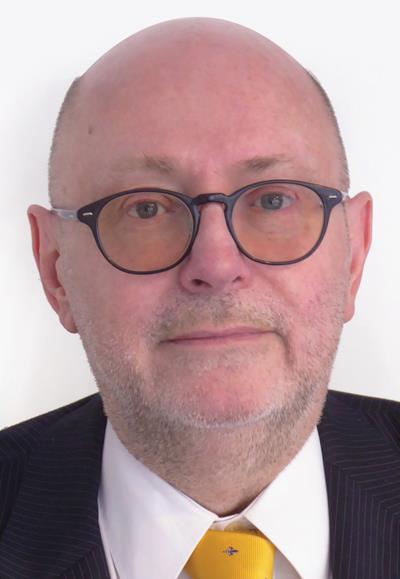18 February 2020

Martin Jarrold, chief of international programme development, GVF
GVF has been a Supporting Association of the Dubai World Trade Centre’s CABSAT exhibition for several years.
2020 brings the 25th event with a Content Distribution section representing the satellite industry ecosystem.
Embedded in the exhibition, the GVF SatExpo Summit, 31 March to 2 April, will feature keynote addresses, themed interactive sessions, and special focus sessions.
Keynote Addresses open the programme. Perspectives from the UAE Telecommunications Regulatory Authority (TRA) and the International Telecommunication Union (ITU) Radio Communication Bureau Space Services Department will include exploration of the outcomes of the ITU World Radiocommunication Conference 2019 (WRC-19) – held last November in Egypt – and agenda items for WRC-23. WRC meetings review, and, if necessary, revise the Radio Regulations, the international treaty governing the use of the radio-frequency spectrum and of geostationary satellite (GEO) and non-geostationary satellite orbits (NGSO).
Space Segment Disruptive Evolution is the theme for the first moderator-led panel session. David Meltzer, Secretary General, GVF, will steer a dialogue on rapid changes in in-orbit technology. The latest GEO high throughput satellites (HTS) are close to achieving near-terabit capacity, existing medium Earth orbit (MEO) constellations are evolving into more powerful systems, and the first of the low Earth orbit (LEO) mega-constellations are launching. Other issues for discussion are the phenomenon of small satellites and generational disruption: miniaturisation and low-cost manufacture, link budgets, latency and constellation functionality, and new customer markets and applications.
Stéphane Chenard, Senior Consultant, Euroconsult, will moderate Ground Segment Disruptive Evolution. As with space segment, infrastructure on the ground is undergoing a game-changing shift. Amongst other trends, teleports are evolving, and antennas/terminals are expected soon to feature cost-effective form-factor and performance departures from the traditional parabolic paradigm. Points of discussion will include teleport operations virtualisation, and the Cloud; the ecosystem of new antenna/terminal technologies; and, meeting the demands of wider markets.
New to the industry lexicon is the term NewSpace. Much has been written about this, sometimes referencing other terminology: Space Industrialisation, Space 2.0, the “New Space Race”. Session moderator Virgil Labrador, Editor in Chief, Satellite Markets & Research, will frame a dialogue for Space Industrialisation and Emergent NewSpace, beginning from the premise that space is no longer the sole preserve of agencies and big commercial players. Smaller private companies are propelling the sector vigorously forward. The industry is undergoing an entrepreneur-driven industrialisation process going beyond the potential offered by the ‘smallsats’ segment. Discussion will question “What are the limits to NewSpace?”, with reference to: Artificial Intelligence (AI)/machine learning; the Industrial Internet of Things (IIoT); orbital connectivity drivers to space industrialisation; new applications; and, competition for customers.
Increasing use of satellite in the maritime sector continues. As the session Verticals: Maritime will examine, it is a vibrant market as ship-owners transition to next generation connectivity. The merchant, passenger and leisure segments are all yielding revenue growth and a re-bounding oil pricing accelerates the offshore segment. Dialogue here will cover: HTS oceanic coverage and capacity trends; capacity and terminal pricing trends and demand forecasts; value-added services and operations outsourcing; and, drivers of new generation satellite system purchases.
GVF has a long-standing engagement with the Humanitarian Assistance & Disaster Response sector, being an industry signatory to the UN Crisis Connectivity Charter. Riaz Lamak, Lead, Capacity Building & HADR, GVF, will moderate. Satellite has a well-recognised critical role in reporting on disaster assistance and appeals for funding but is also mission-critical in organising and delivering humanitarian aid and resources into the field. The topics to be engaged here are: satellite industry engagement with HADR – international agencies, governments/militaries, and NGOs; the first 48-hours – supporting logistics, providing coordination of relief efforts; recovery and rebuilding; satellite communications when terrestrial networks fail; from ‘satphone’ to broadband – requirements in the field; and, from satcoms to EO – expanding applications for HADR.
The final two sessions of the Summit deal with extensive subjects, essentially entire conference subjects in themselves: The Satellite Integral Factor: Cloud; 5G and Robust Connections: Cyber; Interference; Orbital Debris.
Satellite is becoming as integral to the Cloud as it is acknowledged as being integral to roll-out of the next generation mobile standard – 5G. Recognition of the opportunities in partnering with the Cloud is only now working through. Leveraging reduction of CAPEX, reduced OPEX, rapid scalability, ease of development and ubiquitous accessibility is bringing evolutionary change to the satellite value chain, encompassing data volumes and analytics products arising out of satellite communications network operations and generated by NewSpace EO and IoT.
Satellite users depend on reliable and robust connectivity characteristic of today’s platforms, but there are potential vulnerabilities. Three of these will be explored in Dubai.
Cyber Security is a not specific to satellite but concerns the entire IP-enabled global ICT infrastructure. The European Space Agency (ESA) is calling for proposed solutions to determine viability of satellite-based services in support of cyber security and to assess technical feasibility and commercial viability for vertical sector users of satellite. Potential solutions will be enabled by space to mitigate security risks and enhance cyber resistance and the resilience of existing infrastructures, services and operations, contributing to enhanced end-to-end security. So, a key question is, “Is the satellite sector doing enough in the cyber security environment?”
Interference is a vulnerability the satellite industry successfully addresses through technology advance and human capacity-building, (i.e., GVF training), and this topic will question what still needs to be done and will be addressed through the terminal type approvals work of the GVF Mutual Recognition Arrangement Working Group (MRA-WG) and GVF collaboration with ESA and the ITU.
Orbital Debris is a prominent issue. The discussion here will encompass: sustainable space utilisation supporting development on Earth; tools to support collaborative space situational awareness and surveillance; risk models, regulatory regimes, and international coordination and guidance for space actors; space-based applications and the NewSpace age of innovative LEO business; scale and operation of the mega-constellations – orbital debris prevention and operator responsibility; and, maintaining a space sustainability-based future.






